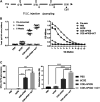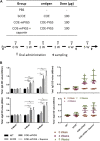Systemic and Oral Immunogenicity of Porcine Epidemic Diarrhea Virus Antigen Fused to Poly-Fc of Immunoglobulin G and Expressed in ΔXT/FT Nicotiana benthamiana Plants
- PMID: 33995068
- PMCID: PMC8120289
- DOI: 10.3389/fphar.2021.653064
Systemic and Oral Immunogenicity of Porcine Epidemic Diarrhea Virus Antigen Fused to Poly-Fc of Immunoglobulin G and Expressed in ΔXT/FT Nicotiana benthamiana Plants
Abstract
Porcine epidemic diarrhea virus (PEDV), a member of the Coronaviridae family has become increasingly probelmatic in the pig farming industry. Currently, there are no effective, globally applicable vaccines against PEDV. Here, we tested a recombinant PEDV vaccine candidate based on the expression of the core neutralising epitope (COE) of PEDV conjugated to polymeric immunoglobulin G scaffold (PIGS) in glycoengineered Nicotiana be nthamiana plants. The biological activity of COE-PIGS was demonstrated by binding to C1q component of the complement system, as well as the surface of antigen-presenting cells (APCs) in vitro. The recombinant COE-PIGS induced humoral and cellular immune responses specific for PEDV after both systemic and mucosal vaccination. Altogether, the data indicated that PEDV antigen fusion to poly-Fc could be a promising vaccine platform against respiratory PEDV infection.
Keywords: PEDV; immunity; mucosal; plant; vaccine.
Copyright © 2021 Tien, Yang, Jang, Kwon, Reljic and Kim.
Conflict of interest statement
Authors T-HK and M-SY were employed by the company Natural Bio-Materials Inc. (NBM). The remaining authors declare that the research was conducted in the absence of any commercial or financial relationships that could be construed as a potential conflict of interest.
Figures





Similar articles
-
Oral Delivery of Probiotics Expressing Dendritic Cell-Targeting Peptide Fused with Porcine Epidemic Diarrhea Virus COE Antigen: A Promising Vaccine Strategy against PEDV.Viruses. 2017 Oct 25;9(11):312. doi: 10.3390/v9110312. Viruses. 2017. PMID: 29068402 Free PMC article.
-
Oral recombinant Lactobacillus vaccine targeting the intestinal microfold cells and dendritic cells for delivering the core neutralizing epitope of porcine epidemic diarrhea virus.Microb Cell Fact. 2018 Feb 9;17(1):20. doi: 10.1186/s12934-018-0861-7. Microb Cell Fact. 2018. PMID: 29426335 Free PMC article.
-
Mucosal immune responses induced by oral administration recombinant Bacillus subtilis expressing the COE antigen of PEDV in newborn piglets.Biosci Rep. 2019 Mar 15;39(3):BSR20182028. doi: 10.1042/BSR20182028. Print 2019 Mar 29. Biosci Rep. 2019. PMID: 30808716 Free PMC article.
-
Porcine epidemic diarrhea virus (PEDV): An update on etiology, transmission, pathogenesis, and prevention and control.Virus Res. 2020 Sep;286:198045. doi: 10.1016/j.virusres.2020.198045. Epub 2020 Jun 2. Virus Res. 2020. PMID: 32502552 Free PMC article. Review.
-
Porcine epidemic diarrhea virus infection: Etiology, epidemiology, pathogenesis and immunoprophylaxis.Vet J. 2015 May;204(2):134-43. doi: 10.1016/j.tvjl.2015.02.017. Epub 2015 Feb 26. Vet J. 2015. PMID: 25841898 Free PMC article. Review.
Cited by
-
A Plant-Derived Maternal Vaccine against Porcine Epidemic Diarrhea Protects Piglets through Maternally Derived Immunity.Vaccines (Basel). 2023 May 9;11(5):965. doi: 10.3390/vaccines11050965. Vaccines (Basel). 2023. PMID: 37243069 Free PMC article.
-
Recent Advances in Oral Vaccines for Animals.Vet Sci. 2024 Aug 5;11(8):353. doi: 10.3390/vetsci11080353. Vet Sci. 2024. PMID: 39195807 Free PMC article. Review.
-
The immunogenicity of plant-based COE-GCN4pII protein in pigs against the highly virulent porcine epidemic diarrhea virus strain from genotype 2.Front Vet Sci. 2022 Jul 28;9:940395. doi: 10.3389/fvets.2022.940395. eCollection 2022. Front Vet Sci. 2022. PMID: 35967993 Free PMC article.
-
Research progress of porcine epidemic diarrhea virus S protein.Front Microbiol. 2024 May 30;15:1396894. doi: 10.3389/fmicb.2024.1396894. eCollection 2024. Front Microbiol. 2024. PMID: 38873162 Free PMC article. Review.
-
Enhancing epitope of PEDV spike protein.Front Microbiol. 2022 Jul 22;13:933249. doi: 10.3389/fmicb.2022.933249. eCollection 2022. Front Microbiol. 2022. PMID: 35935230 Free PMC article.
References
-
- Chang C. Y., Cheng I. C., Chang Y. C., Tsai P. S., Lai S. Y., Huang Y. L., et al. (2019). Identification of neutralizing monoclonal antibodies targeting novel conformational epitopes of the porcine epidemic diarrhoea virus spike protein. Sci. Rep. 9, 2529. 10.1038/s41598-019-39844-5 - DOI - PMC - PubMed
-
- Chang S. H., Bae J. L., Kang T. J., Kim J., Chung G. H., Lim C. W., et al. (2002). Identification of the epitope region capable of inducing neutralizing antibodies against the porcine epidemic diarrhea virus. Mol. Cell 14, 295–299. - PubMed
LinkOut - more resources
Full Text Sources
Other Literature Sources
Miscellaneous

